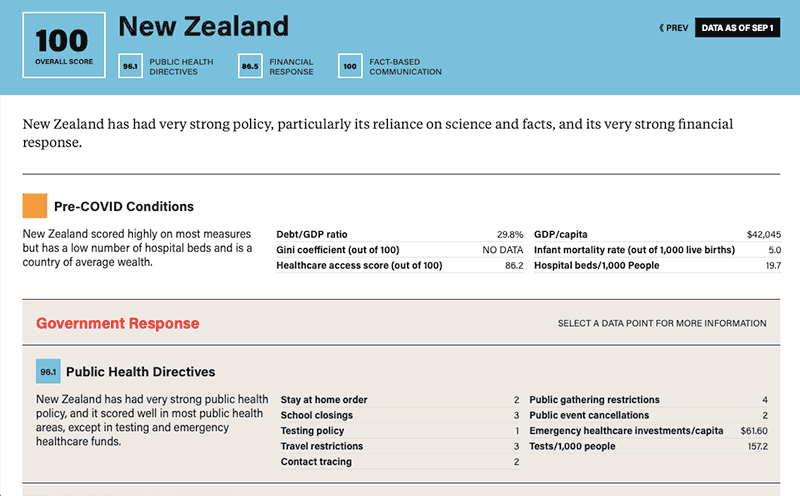Travel and tourism will be changed forever. We asked seven leading thinkers for their predictions.
Denmark
- Data as of Aug 1
- Next 》
- 45.6 Public Health
Directives - 56.3 Financial
Response - 100 Fact-Based
Communication
- 45.6 Public Health
Directives - 56.3 Financial
Response - 100 Fact-Based
Communication
Denmark's score is very strong, due to a robust healthcare system and to generous fiscal responses that safeguarded employment. Public health directives have improved substantially in recent months.
Pre-COVID Conditions
Denmark’s universal healthcare system, coupled with a high GDP per capita and low debt-to-GDP ratio have contributed to its effective pandemic-response policies, though it is hurt by its low number of hospital beds.
- Debt/GDP ratio 34.3%
- GDP/capita $55,675
- Gini coefficient (out of 100) 28.7
- Infant mortality rate (out of 1,000 live births) 4
- Healthcare access score (out of 100) 85.7
- Hospital beds/1,000 People 17.5
Government Response
Select a data point for more information(Data points represent policy level as of Aug 1.)
Public Health Directives
Denmark has had very high testing levels, but relatively low emergency healthcare spending and a relaxed lockdown result in a score around the median.
- Stay at home order 1
- Public gathering restrictions 2
- School closings 2
- Public event cancellations 1
- Testing policy 3
- Emergency healthcare investments/capita $16.59
- Travel restrictions 3
- Tests/1,000 people 3.2
- Contact tracing 2
Financial Response
Denmark’s financial response is characterized by very generous income support and accessible debt-forbearance opportunities.
- Financial stimulus as share of GDP 13.4%
- Income support 2
- Debt forebearance 2
Fact-Based Communication
Denmark’s prime minister conducts weekly briefings that emphasize clear, fact-based messages.
- Reliance on science/fact based information 0
- Press freedom 0
COVID-19 Status as of Aug 1
Denmark has a relatively strong score in this category, with a fairly low death and case rate and a very low positivity rate, meaning that it is testing a wide range of its population.
- Total deaths 615
- Death rate per 100K 106.2
- Total cases 13,789
- Cases per 100K 2,381
- Percent of positive tests 0.3
| Date | Status | New Cases/1M | |
|---|---|---|---|
| 1 | Apr 15 | Primary schools reopen | 35.52 |
| 2 | Apr 20 | Non-essential health care services and some businesses, such as hair salons, reopen | 29.84 |
| 3 | May 11 | Retail stores reopen | 22.35 |
| 4 | May 18 | Restaurants and secondary schools reopen | 12.28 |
| 5 | May 21 | Museums and zoos reopen | 11.10 |
| 6 | May 27 | Cultural activities reopen | 9.47 |
| 7 | Jun 08 | Numbers allowed at public gatherings raised from 10 to 50 | 6.88 |
| 8 | Jul 01 | Numbers allowed at public gatherings raised from 50 to 100 | 5.11 |
Differentiating Factors
- High wage-reimbursement levels: Denmark has kept its rate of unemployment low by reimbursing companies for up to 90 percent of furloughed workers' wages. Read More
- Early action enabling slow re-opening: The government has taken a two-part approach to the pandemic, initially focused on suppression via lockdown, and then mitigation, including contact tracing. In April, it became the first European country to re-open schools. Read More
- Keeping hospital visits low: Primary physicians and general practitioners are responsible for the majority of coronavirus diagnoses, with the aim of keeping hospital visits to a minimum. Read More
Compared with Neighboring Countries
-
71.9Norway 9,208
Cases 1,699
Per 1M 255
DeathsNorway scores just below the median, pulled down by its weak public health and financial response scores, despite a strong reliance on facts and a free press.
-
51.6Sweden 76,937
Cases 7,618
Per 1M 5,762
DeathsDespite being known for a relatively strong public healthcare system, Sweden has been hit hard with cases; the country’s lack of stay-at-home orders and school closures, limited testing, and few gathering restrictions overshadowed its financial support, reliance on facts, and accountability with an open press.
-
67.2Germany 209,653
Cases 2,502
Per 1M 9,141
DeathsGermany has improved its score a bit in the past few months, after a sharp decline in the fall. Its improvements in contact tracing, which are already likely underestimated in the data, and restrictions on public gatherings, have played important roles in this turnaround, although there has been a recent spike in cases, likely due to both recent restriction relaxations and vaccine rollout issues.
Further Reading From Foreign Policy
Be the source of actionable insight.
Select one of the subscription options below to read the full Covid-19 Global Response Index. Unlock even more global intelligence with a subscription to FP Insider.
Already an FP Insider? Log In
Looking for group access? Contact us directly

Statistics and government response factors available on each country profile include:
Pre-COVID Conditions:
- Debt to GDP ratio
- Infant mortality rates
- Hospital beds per 1,000 people
- Gini coefficients measuring inequality
- Health access and quality
COVID-19 Public Health Directives:
- Stay-at home orders
- School-closing policy
- Public-gathering restrictions
- Cancellation of public events
- Testing policy and rates per 1,000 people
- Emergency healthcare spending per capita
- Travel restrictions
- Contact tracing
COVID-19 Financial Response:
- Stimulus package as a share of GDP
- Income support
- Debt-forbearance
Public Communications:
- Instances of misinformation by leadership
- Limitations on press freedom, censorship
Current/Historic In-Country COVID-19 Status:
- Death rates per 1 million
- Case rates per 1 million


